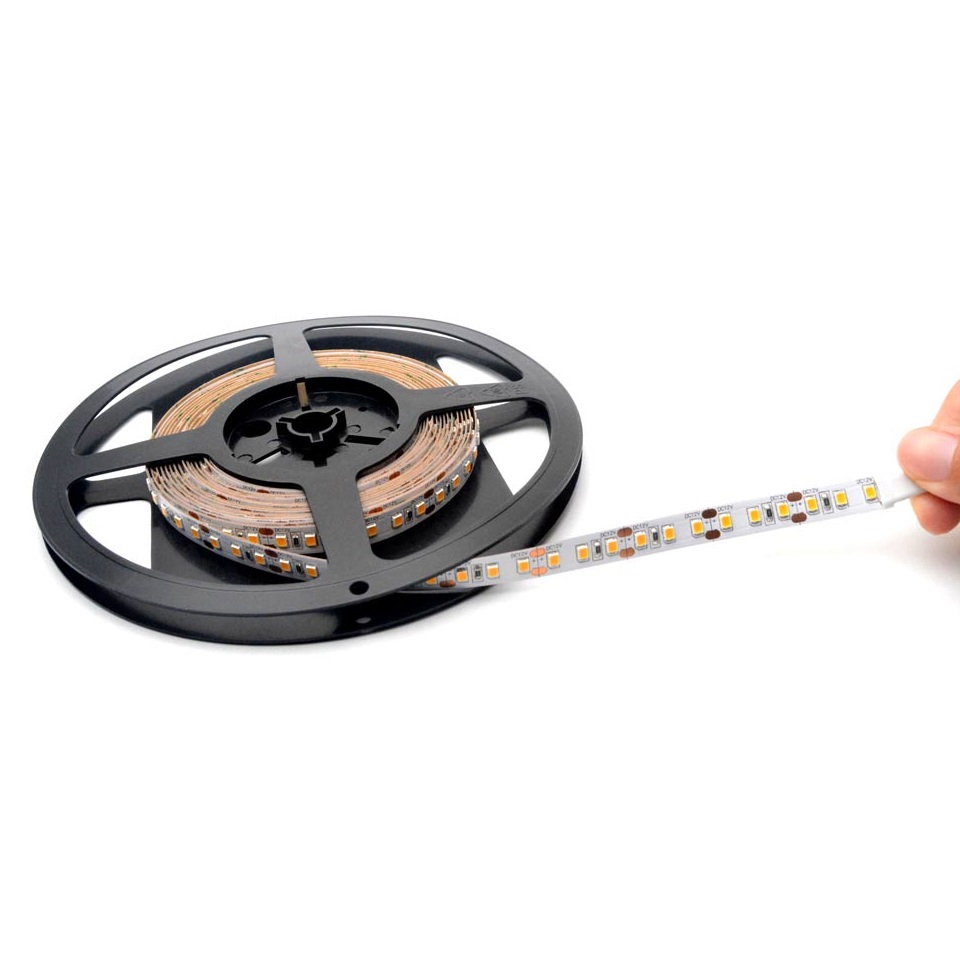
LED STRIP LIGHTS
EVERYTHING YOU NEED TO KNOW BEFORE YOU BUY
What is an LED Strip Light?
LED strip lights are new and versatile forms of lighting. There are many variants and exceptions, but for the most part, they have the following characteristics:
- Consist of many individual LED emitters mounted on a narrow, flexible circuitboard
- Operate on low-voltage DC power
- Are available in a wide range of fixed and variable color and brightness
- Ship in a long reel (typically 16 feet / 5 meters), can be cut to length, and includes double-sided adhesive for mounting


What is an LED Strip Light?
LED strip lights are new and versatile forms of lighting. There are many variants and exceptions, but for the most part, they have the following characteristics:
- Consist of many individual LED emitters mounted on a narrow, flexible circuitboard
- Operate on low-voltage DC power
- Are available in a wide range of fixed and variable color and brightness
- Ship in a long reel (typically 16 feet / 5 meters), can be cut to length, and includes double-sided adhesive for mounting
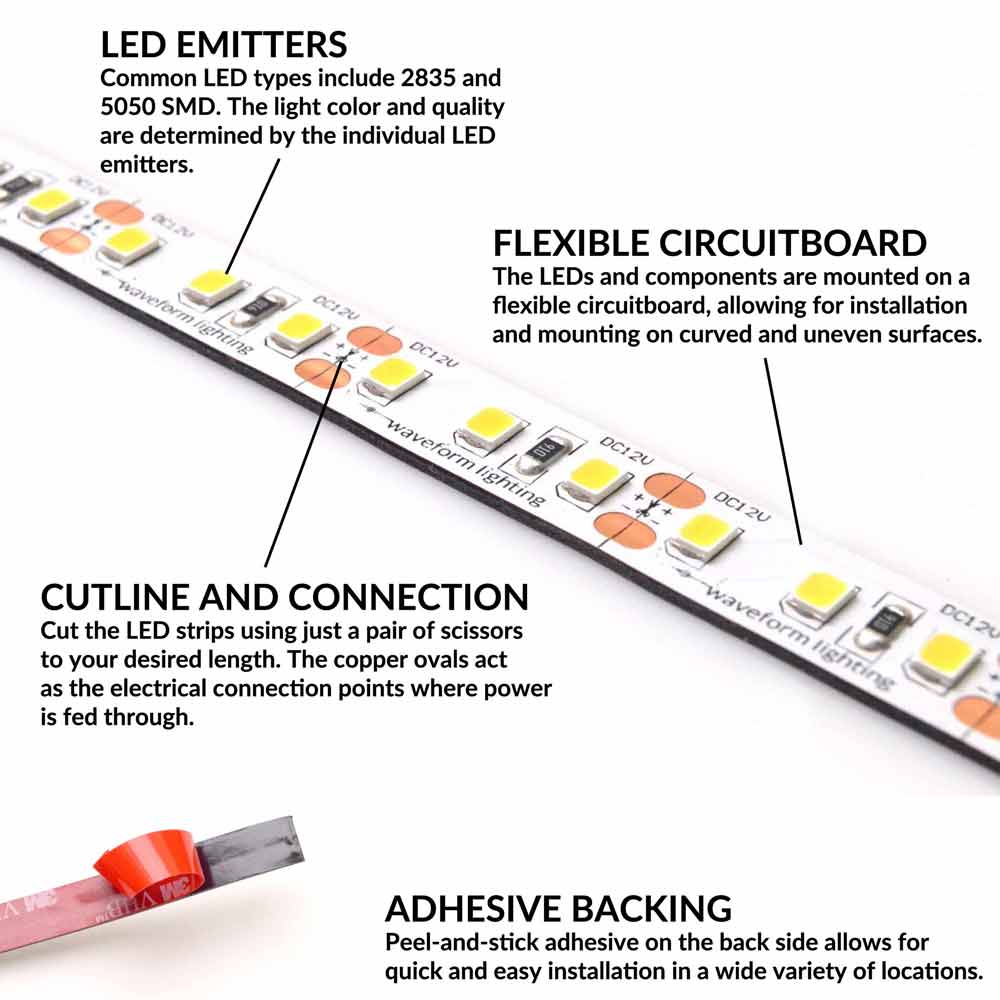
Anatomy of an LED strip
An LED strip light is typically half an inch (10-12 mm) in width, and up to 16 feet (5 meters) or more in length. They can be cut to specific lengths using just a pair of scissors along the cutlines, located every 1-2 inches.
Individual LEDs are mounted along the strip, typically at densities of 18-36 LEDs per foot (60-120 per meter). The light color and quality of the individual LEDs determine the overall light color and quality of the LED strip.
The backside of the LED strip includes pre-applied double-sided adhesive. Simply peel off the liner, and mount the LED strip to virtually any surface. Because the circuitboard is designed to be flexible, LED strips can be mounted on curved and uneven surfaces.
Determining LED Strip Brightness
Brightness of LED strips is determined using the metric lumens. Unlike incandescent bulbs, different LED strips can have different levels of efficiency, so a wattage rating is not always meaningful in determining actual light output.
LED strip brightness is typically described in lumens per foot (or meter). A good quality LED strip should provide at least 450 lumens per foot (1500 lumens per meter), which provides approximately the same amount of light output per foot as a traditional T8 fluorescent lamp. (E.g. 4-ft T8 fluorescent = 4-ft of LED strip = 1800 lumens).
LED strip brightness is primarily determined by three factors:
- Light output and efficiency per LED emitter
- The number of LEDs per foot
- The power draw of the LED strip per foot
An LED strip light without a brightness specification in lumens is a red flag. You will also want to watch out for low cost LED strips that claim high brightness, as they may overdrive the LEDs to the point of premature failure.
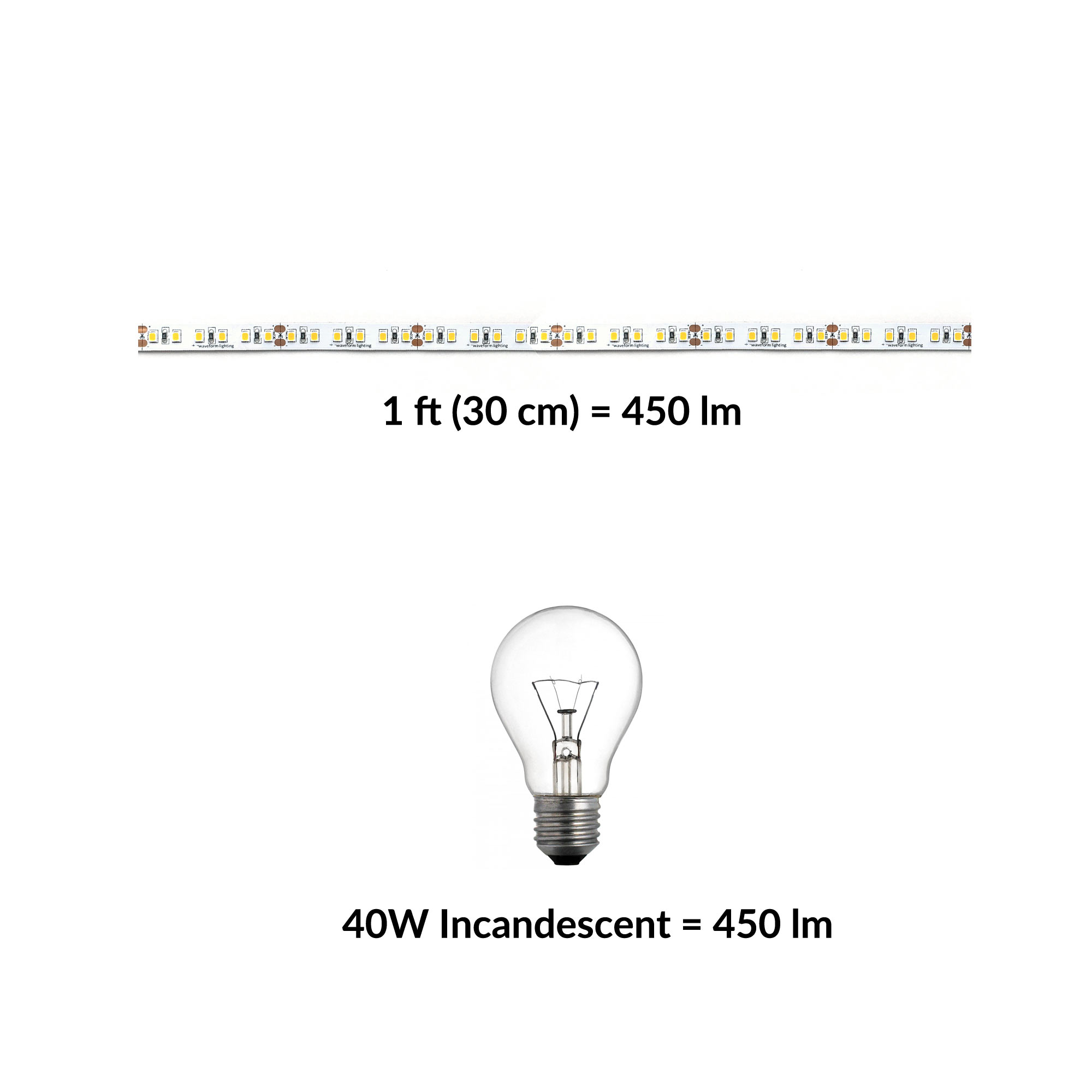

Determining LED Strip Brightness
Brightness of LED strips is determined using the metric lumens. Unlike incandescent bulbs, different LED strips can have different levels of efficiency, so a wattage rating is not always meaningful in determining actual light output.
LED strip brightness is typically described in lumens per foot (or meter). A good quality LED strip should provide at least 450 lumens per foot (1500 lumens per meter), which provides approximately the same amount of light output per foot as a traditional T8 fluorescent lamp. (E.g. 4-ft T8 fluorescent = 4-ft of LED strip = 1800 lumens).
LED strip brightness is primarily determined by three factors:
- Light output and efficiency per LED emitter
- The number of LEDs per foot
- The power draw of the LED strip per foot
An LED strip light without a brightness specification in lumens is a red flag. You will also want to watch out for low cost LED strips that claim high brightness, as they may overdrive the LEDs to the point of premature failure.
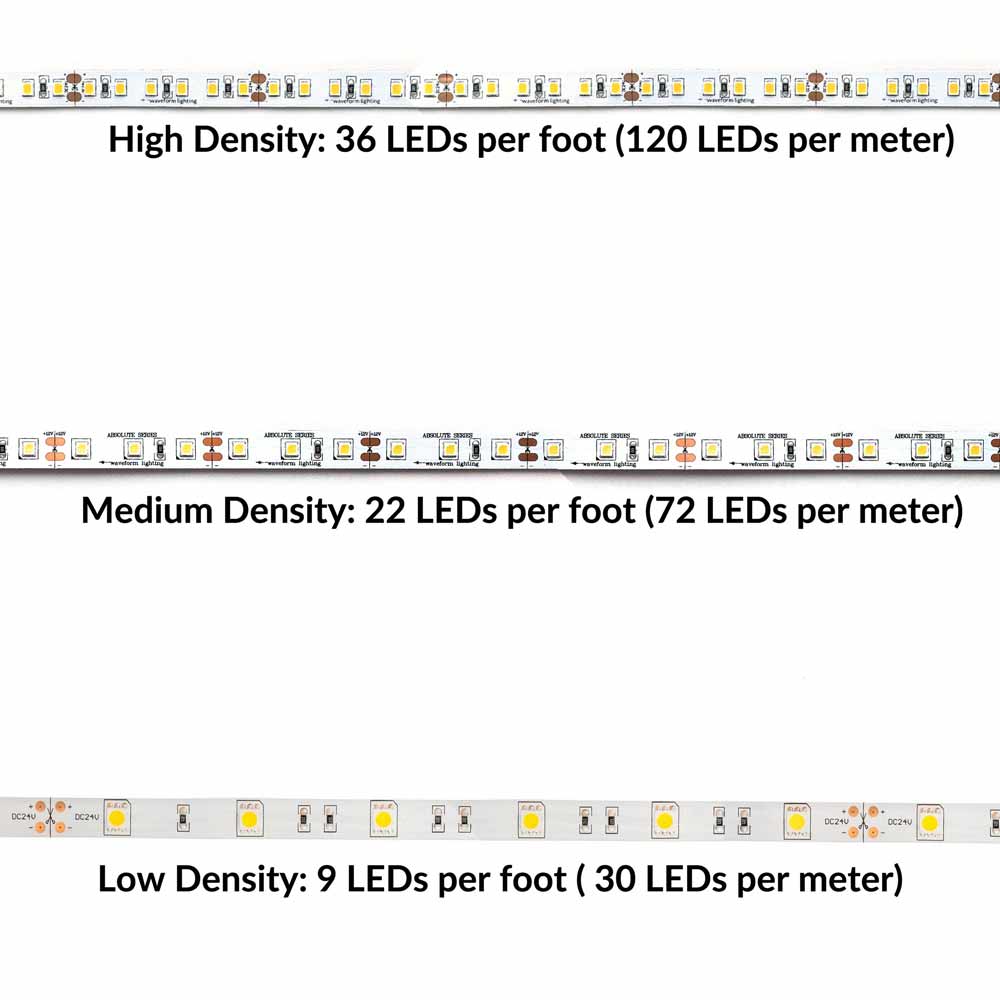
LED Density & Power Draw
You may come across various LED emitter names such as 2835, 3528, 5050 or 5730. Do not worry too much about this, as what is most important in an LED strip is the number of LEDs per foot, and the power draw per foot.
LED density is important in determining the distance between LEDs (pitch) and whether or not there will be visible hotspots and dark spots between the LED emitters. A higher density of 36 LEDs per foot (120 LEDs per meter) will typically provide the best, most evenly distributed lighting effect. LED emitters are the most expensive component of LED strip manufacturing, so be sure to account for LED density differences when comparing LED strip prices.
Next, consider an LED strip light's power draw per foot. The power draw tells us the amount of power the system will consume, so this is important to determine your electricity costs and power supply requirements (see below). A good quality LED strip should be capable of providing 4 watts per foot or more (15 W/meter).
Finally, do a quick check to determine if the individual LEDs are being overdriven by dividing the wattage per foot by the LED density per foot. For an LED strip product, it is usually a good sign if the LEDs are not driven at more than 0.2 watts each.
Learn more about the factors that affect LED strip light longevity.
LED Strip Color Options: White
LED strip lights are available in various shades of whites or colors. Generally, white light is the most useful and popular option for indoor lighting applications.
In describing the different shades and qualities of white, color temperature (CCT) and color rendering index (CRI) are two metrics that are important to keep in mind.
Color temperature is a measure of how "warm" or "cool" the light's color appears. The soft glow of a traditional incandescent bulb has a low color temperature (2700K), while the crisp, bright white of natural daylight has a high color temperature (6500K).
Color rendering is a measure of how accurate colors appear under the light source. Under a low CRI LED strip, colors might appear distorted, washed out, or indistinguishable. High CRI LED products offer light that allows objects to appear the way they would under an ideal light source such as a halogen lamp, or natural daylight. Also look for a light source's R9 value, which provides further information about how red colors are rendered.
Need help deciding which color temperature to choose? See our tutorial here.
Adjust the sliders below for a visual demonstration of CRI vs CCT in action.
Warmer ← CCT → Cooler
Lower ← CRI → Higher

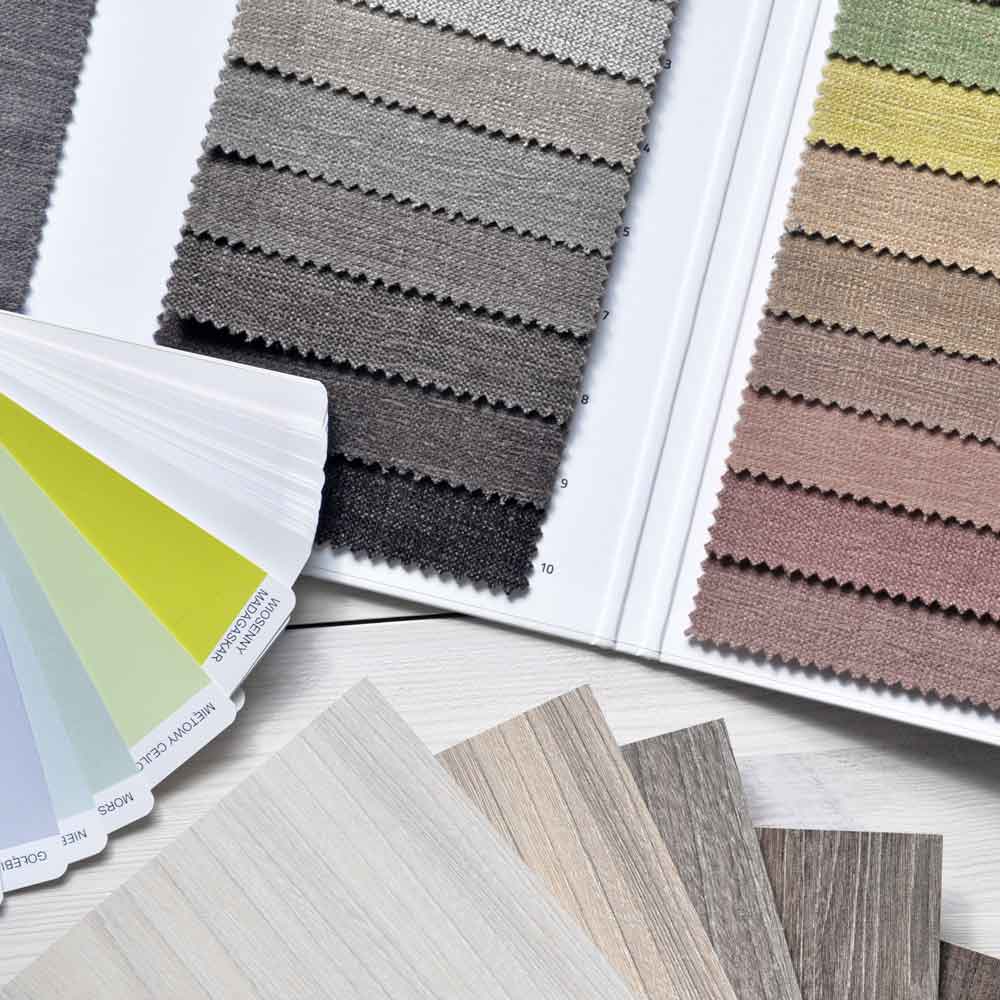


LED Strip Color Options: Fixed and Variable Color
Sometimes, you might need a punchy, saturated color effect. For these situations, colored LED strips can offer great accent and theatrical lighting effects. Colors across the entire visible spectrum are available - violet, blue, green, amber, red - and even ultraviolet or infrared.
There are two primary types of colored LED strip: fixed single color, and color changing. A fixed color LED strip emits just one color, and the operating principle is just like the white LED strips we discussed above. A color-changing LED strip consists of multiple color channels on a single LED strip. The most basic type will include red, green and blue channels (RGB), allowing you to dynamically mix the various color components on the fly to achieve virtually any color.
Some will allow for dynamic control of white color temperature tuning or even both color temperature and RGB hues.
Pictured here is our SimpleColor™ Violet LED strip light inside of our aluminum channel.
Input Voltage & Power Supply
Most LED strips are configured to operate at 12V or 24V DC. When running off of a standard mains supply power source (e.g. household wall outlet) at 120/240V AC, the power needs to be converted to the appropriate low voltage DC signal. This is most frequently and simply accomplished using a DC power supply.
Make sure that your power supply has enough power capacity to power the LED strips (detailed steps here). Every DC power supply will list its maximum rated current (in Amps) or power (in Watts). Determine the total power draw of the LED strip using the following formula:
- Power = LED power (per ft) x LED strip length (in ft)
Example scenario connecting 5 ft of LED strip where LED strip power consumption is 4 Watts per foot:
- Power = 4 Watts per ft x 5 ft = 20 Watts
The power draw per foot (or meter) is almost always listed in an LED strip's datasheet.
Not sure if you should choose between 12V and 24V? All else equal, 24V is typically your best bet. Read more here.
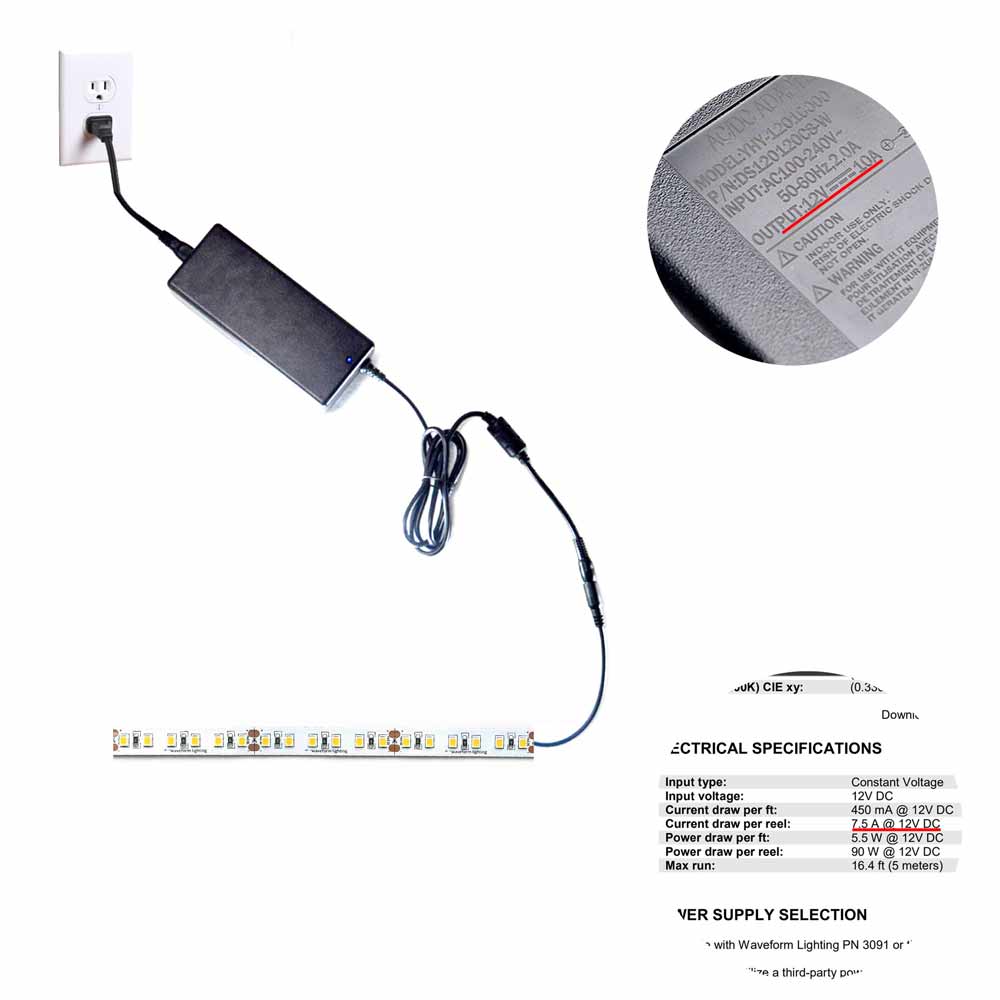

Input Voltage & Power Supply
Most LED strips are configured to operate at 12V or 24V DC. When running off of a standard mains supply power source (e.g. household wall outlet) at 120/240V AC, the power needs to be converted to the appropriate low voltage DC signal. This is most frequently and simply accomplished using a DC power supply.
Make sure that your power supply has enough power capacity to power the LED strips (detailed steps here). Every DC power supply will list its maximum rated current (in Amps) or power (in Watts). Determine the total power draw of the LED strip using the following formula:
- Power = LED power (per ft) x LED strip length (in ft)
Example scenario connecting 5 ft of LED strip where LED strip power consumption is 4 Watts per foot:
- Power = 4 Watts per ft x 5 ft = 20 Watts
The power draw per foot (or meter) is almost always listed in an LED strip's datasheet.
Not sure if you should choose between 12V and 24V? All else equal, 24V is typically your best bet. Read more here.
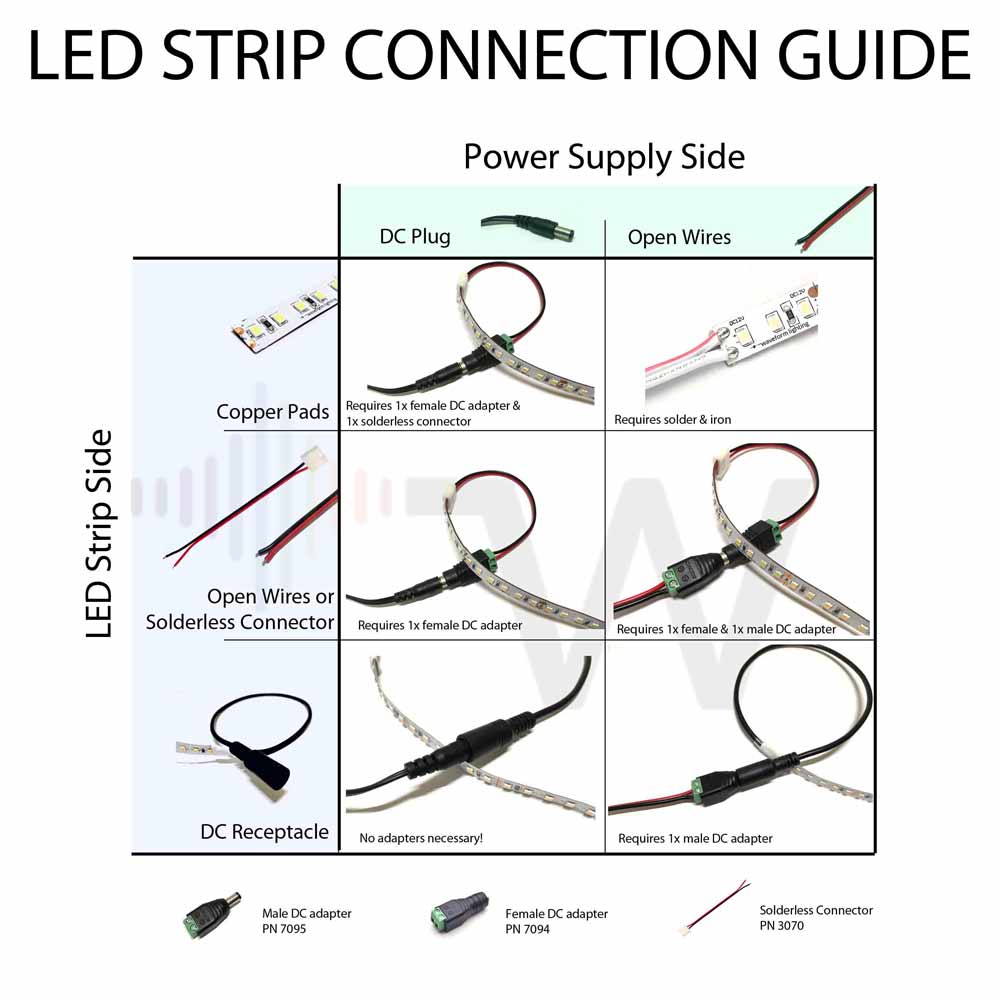
How to Connect LED Strips
Each LED strip segment must be connected to a DC power supply, or another LED strip segment that is connected to a DC power supply (daisy chain). The connection method will depend on the type of wires or plugs provided with the LED strip, as well as whether or not the DC power supply includes a plug. If you are familiar and comfortable with soldering, oftentimes this can provide the most cost effective and flexible solution.
Not sure how or don't want to deal with solder? You can also use solderless connector accessories to connect LED strip segments to power supplies and other LED strip segments.
More Info →Aluminum Channels & Heatsinking
Despite their versatility and ease of use, LED strips are nonetheless bare circuitboard components. Mounting the LED strips inside of an aluminum channel, along with a diffuser cover, can significantly improve the aesthetics of a lighting installation.
Aluminum channels are typically long pieces of extruded aluminum in a U or V shape. The LED strip is them placed and secured (using the double sided tape) at the bottom of the channel. A long piece of frosted polycarbonate plastic (typically provided with the aluminum channel) then snaps onto the top of the aluminum channel.
You may have correctly read elsewhere that LEDs need effective thermal management for reliable operation. Higher quality LED strip light products actually underdrive the LEDs, and are designed to last tens of thousands of hours without any heatsinking. During operation, the LED strip can get warm to the touch, but the temperature rise is far below the thermal limits of the LEDs and circuitboard components. (Our products typically exhibit temperature rises of 55 F or 30 C over ambient temperatures, without any heatsinking).
The aluminum channels may help dissipate the heat from the LED strips, but for the most part they are not necessary for thermal management and are primarily for mounting and diffusion purposes.
Learn More →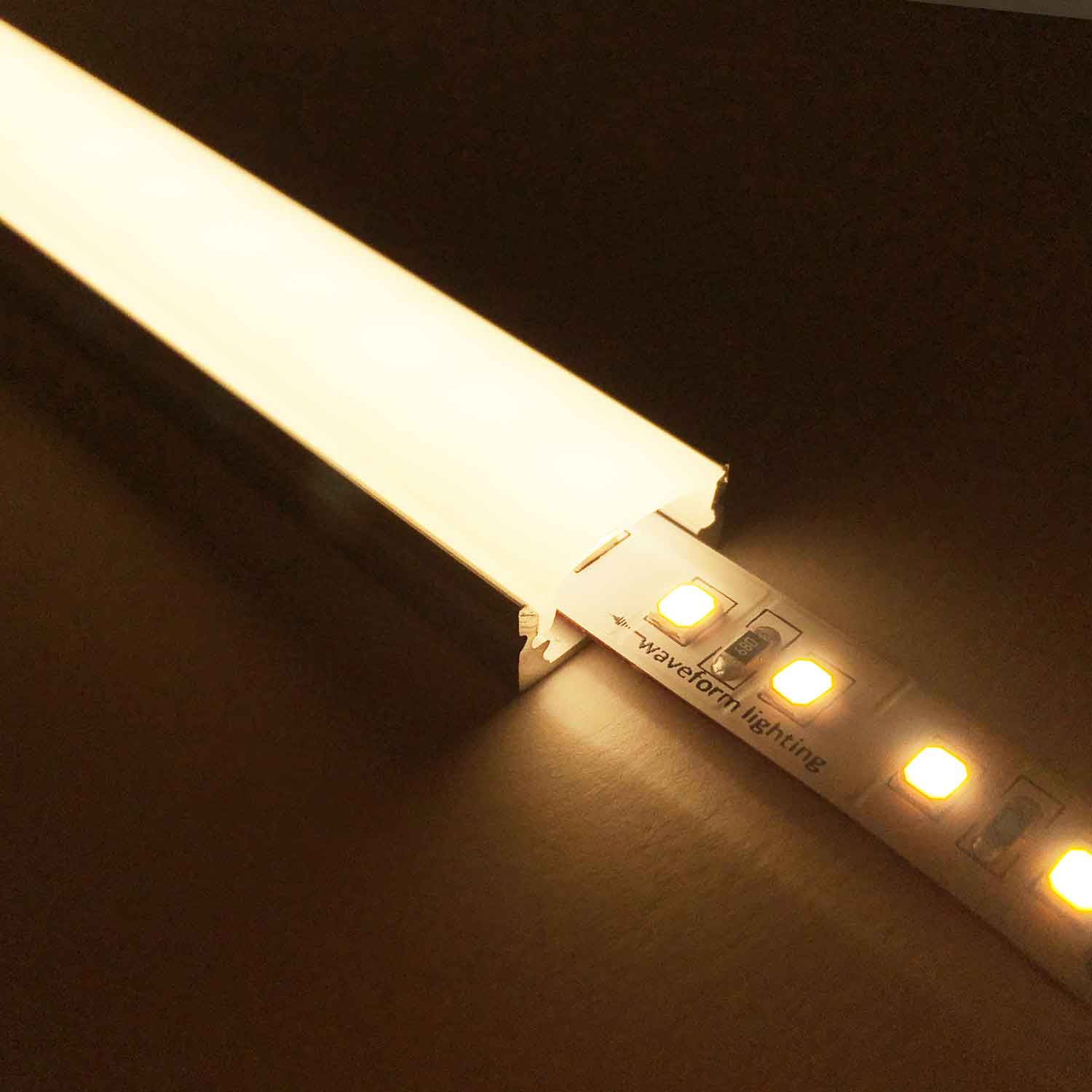
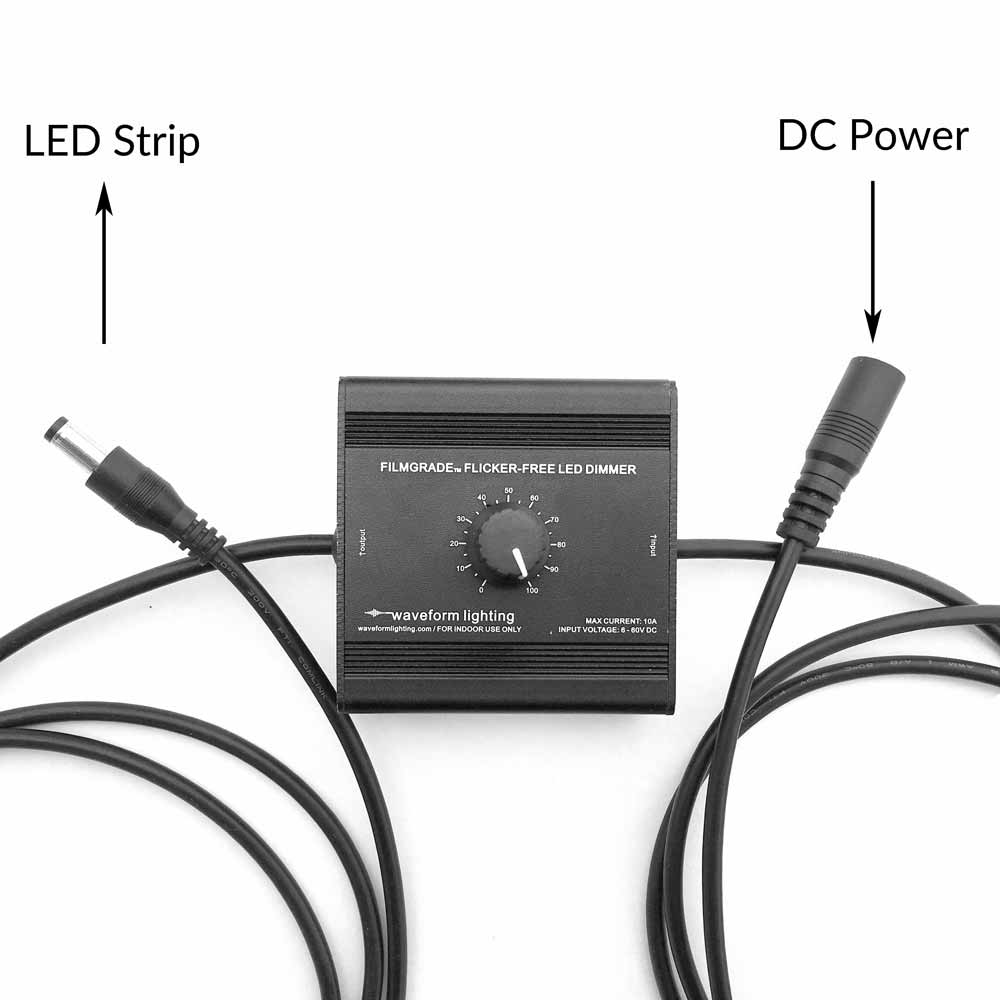
Dimming and Color Control
Unlike LED bulbs, all LED strips are dimmable when paired with the correct equipment. There are two methods of dimming LED strips: a traditional phase-cut wall-dimmer, or a DC low-voltage dimmer. The AC phase-cut dimmer approach is typically most ideal for residential and commercial lighting applications where the dimming input signal comes from a traditional wall-switch dimmer. This setup requires a TRIAC dimmable power supply.
A DC low-voltage dimmer or (RGB) controller is typically in the form of a manual or digital dimmer module that is placed between the DC power supply and the LED strip. This approach is best suited for color changing applications or less permanent lighting installations.
Learn More →Determining LED Strip Quality
Sometimes, it can be tricky to distinguish between LED strip lights designed for high performance and longevity, and those that are not. Below are some pointers for knowing where to look.
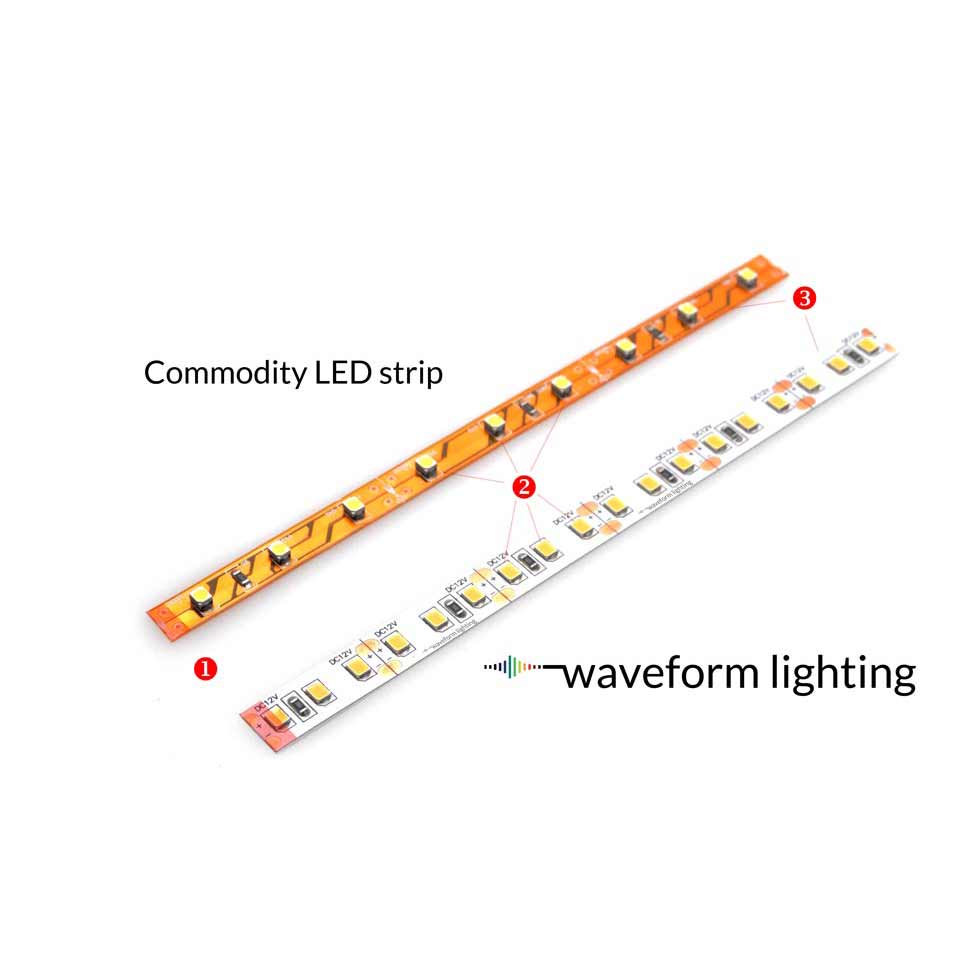

Determining LED Strip Quality
Sometimes, it can be tricky to distinguish between LED strip lights designed for high performance and longevity, and those that are not. Below are some pointers for knowing where to look.
Waveform Lighting LED Strip Lights
$99.00
CENTRIC HOME™ LED Strip Lights for Home & Residential
$99.00
CENTRIC DAYLIGHT™ LED Strip Lights for Commercial & Retail
$99.00
CENTRIC WARM™ LED Strip Lights
$195.00
DynaWhite™ Dim-to-Warm LED Flexible Strip
$375.00
ABSOLUTE SERIES™ LED Flexible Strip - 99 CRI - D50 / D65
$109.00
FilmGrade™ WHITE LED Strip Lights
$139.00
FilmGrade™ HYBRID LED Strip Lights
$145.00
ColorSpace™ RGB Color Changing LED Strip Lights
$275.00
FilmGrade™ FiveSpect 5-in-1 LED Strip Lights
$35.00
realUV™ LED Strip Lights
$275.00
FilmGrade™ HYBRID LED Flex Panel
$95.00
SimpleColor™ Green LED Strip Lights
$95.00
SimpleColor™ Blue LED Strip Lights
$95.00
SimpleColor™ Violet LED Strip Lights
$95.00
SimpleColor™ Amber LED Strip Lights
$95.00
SimpleColor™ Red LED Strip Lights
$35.00
Infrared 850 nm IR LED Strip Light
$29.00
Sidewinder™ LED Flex Strip for D65 Bias Lighting
$245.00
cleanUV™ UV-C LED Strip Light
$245.00
realUV™ LED Flex Panel
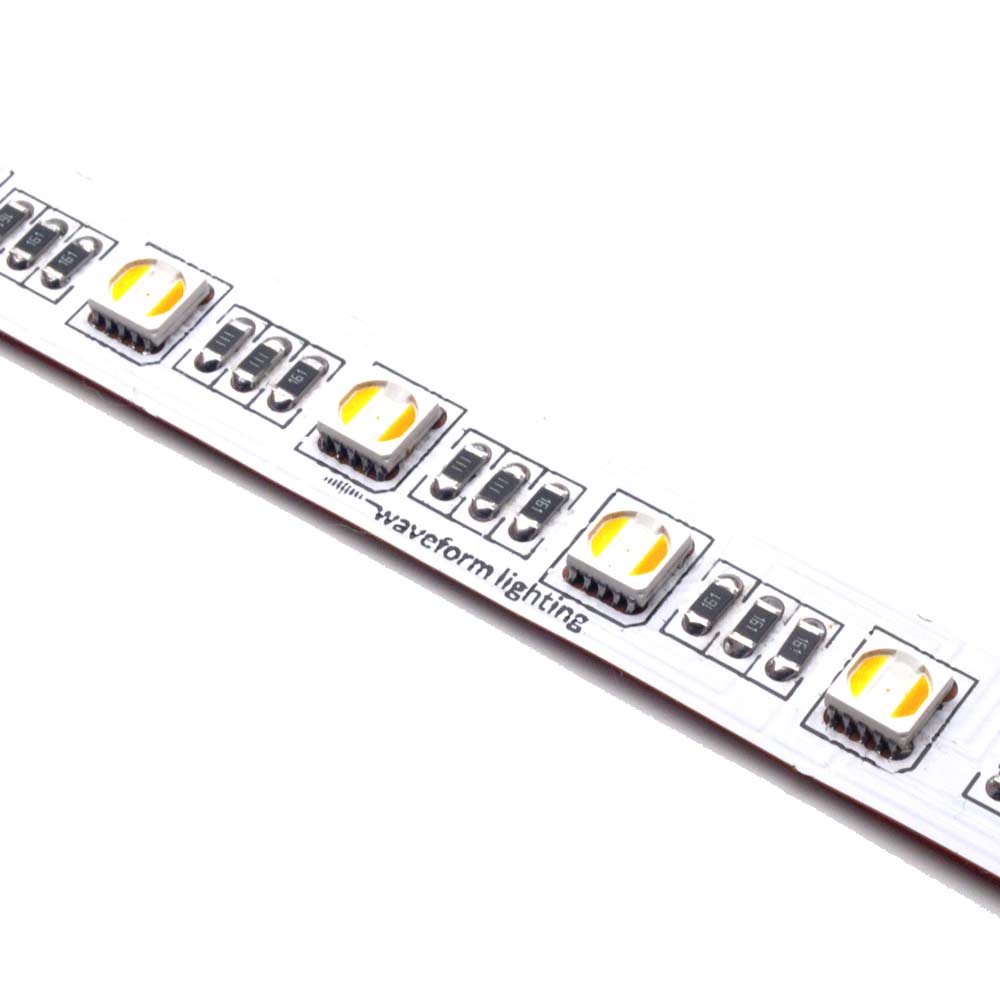
Further Reading
Interested in more information? Below are links for further information on LED strips
- Pros and cons of a 12V LED system
- Getting started with LED strip lighting for your home
- Things to know about flexible LED strip substrates
- How to choose a power supply for your LED strip project
- How to choose LED strip voltage
- LED Strip Light Internal Schematic and Voltage Information
- What LED strip light color temperature should I choose?
- What is LED strip voltage drop?
- How long do LED strip lights last?
- Do LED strip lights require UL listing?
- What does LED density on an LED strip mean?
- What is the CRI spec on LED strips?
- How to Dim LED Strip Lights
- An Introduction to Flicker Free LED Strip Dimming
- How to Connect An LED Strip to a Power Supply
- Using a 12V LED Strip in a 24V System
- LED Strip Light Wire Gauge & Voltage Drop Calculator
- Powering LED Strips With a Battery
- Troubleshooting LED Strip Problems
Browse LED Strips →
Want to learn more?
Visit our product support center to learn more about our products. Download spec sheets, test reports and reach out to us with any questions.
